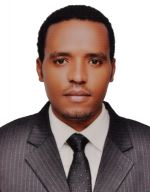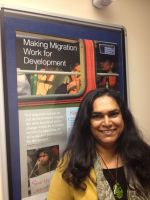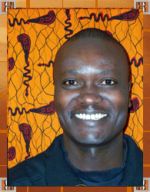Presenters’ biographies

Ms Adamnesh Atnafu
Adamnesh Atnafu studied Law as an undergraduate at Addis Ababa University where she also undertook a Master’s degree in Regional and Local Development Studies (RLDS), submitting a thesis on ‘Aspects of Ethiopian Return Migration’. She is currently a PhD candidate in the School of Social Work at Addis Ababa University, researching international migration. She conducts research on social issues including women, children and issues of migration. She has also evaluated research projects, prepared training manuals, conducted training, gender audits, policy analysis, situation analysis/baseline surveys, and assessment reports.

Professor Mariama Awumbila
Mariama Awumbila is currently Head, Centre for Migration Studies and also Senior Lecturer in the Department of Geography and Resource Development at the University of Ghana. Her research interests include: population, gender, environment and development inter-relationships, migration and development, and participatory research methodologies. She has undertaken extensive research and published in the areas of migration, livelihoods and development, land and natural resource tenure and management, gender and development and poverty reduction strategies. She has also provided extension services for several national and international agencies and community based organisations in Ghana. She is a member of the International Geographical Union (IGU) steering committee on Gender and Geography, the Union of African Population Scientists, and the Ghana Geographical Association. She currently serves on several national Boards including the Ghana Statistical Service Board, the Ghana National Council for Tertiary Education, and the University Council of the University for Development Studies, Tamale, Ghana, among others.
-
Urbanisation and Changing Dynamics of Migrant Domestic Work in Accra
Abstract
Rapid urban population growth and increasing urbanisation are evident in Ghana. By 2010 the proportion of the population living in urban areas was 50.9% up from 43.8% in 2000 (GSS, 2012) and projected to increase to 63% by 2025. The contribution of migration to the urbanisation process in Ghana is estimated to be significant. Rural- urban migration has been an integral part of people's livelihood strategy in Ghana. For women, although urbanisation presents more job opportunities, greater independence and fewer economic and cultural constraints, recent research indicates that it may not always result in a fairer distribution of resources and ability to secure assets.
Women and girls’ migration and its linkages with urbanisation in Ghana has not received much attention in the migration literature. Much of this literature has tended to focus on female migrant head porters (kayayei) in Ghana’s cities and large towns, who are very visible in the urban markets of Ghana. Much less researched in Ghana is the movement of women and girls into urban areas entering the private informal economy as domestic workers. Even though research data on domestic workers is almost non-existent for Ghana, domestic work is believed to engage a substantial segment of the workforce. In Ghana domestic workers in urban areas, the majority of whom are female, are largely undocumented and unregulated.
Based on a study of migrant domestic workers in low, middle and high income areas of the city of Accra, the paper examines the dynamics of migration and domestic work in Ghana in a growing informal economy and in the context of increasing urbanisation. The paper finds that many households, irrespective of their income status, employ domestic workers on a wide range of terms and conditions. As a result of the informal nature of domestic work and its recruitment processes, domestic workers work and live under very difficult conditions and lack of health benefits. Recruitment systems, involving individuals and agencies, link employers (households) of domestic care workers to the origin of potential migrant domestic workers.
Despite these, domestic workers make critical contributions to the reproductive activities of households, to the care economy and to sending remittances back home, thus underlining their importance to the economy and social system in Ghana. Given the recent evidence which indicates that internal remittances in Ghana may far exceed international remittances, the paper urges the need for a focus on internal migrant workers in the informal private economy.

Mr Jali Bekele
Jali Bekele is a lecturer at Wolaita Sodo University, Ethiopia. He has an MSc in Economics with emphasis on policy analysis. He is interested in social problems related to poverty, inequality and political economy. His MSc thesis examines the poverty implications of trade liberalization measures in sub-Saharan African countries.

Professor Richard Black
Richard Black is the Head of the School of Global Studies at the University of Sussex. He is also the Chief Executive Officer (CEO) of the Migrating out of Poverty Research Programme Consortium. His research interests focus on the study of international migration, including forced migration and post-conflict return, and related social, economic and environmental transformations. Working with colleagues at Sussex and elsewhere, he has recently been involved in developing new approaches to the understanding of the consequences of climate change for migration patterns globally. He also actively researches and writes on the development of public policy on migration and poverty, especially in poor countries, and on immigrant integration in the UK, particularly relating to recent East European and African migrations. His work on migration and poverty is linked to the Migrating out of Poverty consortium, and an EU-funded project on Migration from Africa to Europe (MAFE).

Dr Deborah Bryceson
Deborah Fahy Bryceson is a Reader at the Geographical and Earth Sciences School at the University of Glasgow. She did her Bachelors and Masters degrees in Geography at the University of Dar es Salaam, and a DPhil at Oxford University. Her work has been grounded in studying the transformation of social and economic life from agrarian to more urban-based livelihood, settlement and mobility patterns, and pioneered the concept of de-agrarianisation. She is currently coordinating a research programme on Urbanization and Poverty in Mining Africa (UPIMA) and has edited a Special Issue of the Journal of Contemporary African Studies (2012) entitled Urbanization and Mining: Population, Settlement and Welfare.
-
Tunnelling out of Poverty? Miners’ Mobility and Livelihood Strategies in Urbanising Tanzania
Abstract
For several decades, rural dwellers in Africa have faced declining agrarian economies. Now, however, multiple discoveries of gold and precious stones have attracted large numbers of prospective small-scale miners in a number of mineral-rich countries. While their rush to, and activities within, mining sites are increasingly being studied, there is dearth of analysis on miners’ mobility patterns and material outcomes from the perspective of their work careers and overall urban growth patterns. On the basis of survey findings and interviews at two gold-mining sites in Tanzania, why and when miners leave one site in favour of another is considered. Aspects of differentiated mobility patterns and livelihood strategies emerge. Movement to the first site involves looking for a lucrative income opportunity close to home or alternatively, for those coming from afar, a venture into the unknown, whereas moving to subsequent sites is calculated with awareness of the many risks entailed. Early arrival at gold strike sites is beneficial. Miners with the highest site mobility tend to be more affluent than the others, suggesting that movement can be rewarding for those willing to undertake the hard work and social networking demands of mining yet another site. Finally, cumulatively mining-focussed migration has given impetus to widespread small town growth, which ultimately has potential for livelihood strategies beyond mining.

Professor Samuel Nii Ardey Codjoe
Samuel Nii Ardey Codjoe is the Director of the Regional Institute for Population Studies (RIPS) at the University of Ghana, Legon, where he is also Associate Professor of Population. Within the University of Ghana he teaches at the Centre for Migration Studies, Centre for Social Policy Studies, Department of Geography and Resource Development, and the Institute for Statistical, Social and Economic Research, and is currently an external examiner at the Department of Population Studies, University of Botswana. He obtained an undergraduate degree in Geography and Resource Development from the University of Ghana, a Master of Philosophy degree in Human Geography from the University of Oslo, Norway, and gained his doctorate in Geography and Soil Science from the University of Bonn, Germany.
Samuel Nii Ardey Codjoe has published extensively in the areas of his research interests, including the population-environment nexus, migration, fertility, and climate change/variability and its impact on urban and rural livelihoods, and has won several awards including the Best Researcher for 2010/2011 Academic Year, Faculty of Social Sciences, University of Ghana and the Emerald Literati Network Highly Commended Paper Award for 2011. He has held visiting appointments and engaged in research collaborations at the Carolina Population Centre, University of North Carolina, USA; Ohio State University, USA; University of Bonn, Germany; University of Southampton, UK; and Penn State University, USA. He is currently Project Leader of the African Adaptation Research Centre of Excellence Initiative, sponsored by the International Development Research Centre (IDRC), Canada.
Samuel Nii Ardey Codjoe is the Vice President of the Union for African Population Studies, a member of the Population Association of America, and of the International Union for the Scientific Study of Population. He is also a member of the Editorial Board of The Ghana Social Science Journal.
-
Emerging Urban System Demographic Trends in Ghana: Policy Implications for Ghana and Lessons for Sub-Saharan Africa
Abstract
African countries face major challenges related to their urban demographic structure and dynamics. Governments of the region have responded by developing national urban policies. Yet, data on urban systems in the region is limited so institutions developed generalisations about urban systems that seem to inform national urban policies. We argue that to develop national urban policies that reflect what exists in African countries, we need to understand the structure and dynamics of its urban systems. This is because urban systems are produced based on societal imperatives. Our analyses of the Ghanaian urban system reveal it is difficult to ascertain whether Ghana is in its urban age but it is fast approaching that age. Ghana’s urban system is dominated by two main urban centres in the southern part of the country (Accra-Tema and Kumasi) which exhibit a primacy relationship with the rest of the urban system. Most urban localities have grown at or near the systematic average but societal imperatives underlie urban localities that have experienced remarkable growth. We identify the emergence of a city-region around Accra-Tema since independence and this has intensified and matured since the era of globalization. Based on these findings we suggest ways by which Ghana’s national urban policy can be strengthened and identify three general lessons for sub-Saharan African countries.

Professor Owen Crankshaw
Owen Crankshaw is a Professor in the Sociology Department at University of Cape Town. Prior to this appointment, he was a senior researcher at the Human Sciences Research Council and the Centre for Policy Studies in Johannesburg. He has also lectured at the University of Natal, the University of the Witwatersrand and the London School of Economics. He published Race, Class and the Changing Division of Labour Under Apartheid in 1997. In 2002, he co-authored (with Jo Beall and Susan Parnell) Uniting a Divided City: Governance and social exclusion in Johannesburg. He has also published in peer-reviewed journals. His current research addresses the debate in the urban studies literature concerning the nature of social inequality in post-industrial cities.
-
Social Polarisation and Low-Skilled Migration to Johannesburg
Jacqueline Borel-Saladin and Owen Crankshaw, presented by Professor Owen Crankshaw
Abstract
The manufacturing sector, once a major source of urban employment and consisting of a large percentage of skilled and semi-skilled, middle-income jobs has declined while the service sector, argued to comprise predominantly either high-skill, high-pay or low-skill, low-pay jobs, has grown. Thus, one argument is that the decline of manufacturing and the growth of the service sector results in a polarized occupational structure. Low-wage, low-skill service sector jobs are argued to attract immigrants from rural areas or developing countries who are poorly educated and unskilled Thus, the contention is that migrants become trapped in these low-skilled and low-wage service sector jobs.
An alternative argument is that post-industrial cities do not have a polarized occupational structure. Instead, there is a general upgrading of skills among the employed workforce and a growth of non-manual clerical, sales, professional and managerial jobs. Consequently, poor migrants experience a skills mismatch and are likely to be unemployed rather than employed in low-skilled jobs. Using household survey and population census results for the Johannesburg region of South Africa from 1980 to 2010, the following questions are addressed. Is the occupational structure of the employed workforce becoming polarized due to the growth of low-wage service sector jobs? How much of this polarization is due to the employment of low-skilled in-migrants? Our results show that in spite of the large growth in supply of low-skilled workers, there has been less growth in low-income jobs than in middle-income and high-income jobs. The result is that there is high unemployment among low-skilled workers, many of whom are migrants. However, although migrants are over-represented in the unskilled, low-wage occupations, they are also well-represented in both middle-income clerical and sales jobs and in high-income professional and managerial jobs. So, the post-industrial economy has had a mixed impact on job opportunities for migrants
Full paper

Dr Priya Deshingkar
Priya Deshingkar is Research Director at the Migrating out of Poverty Research Programme Consortium (RPC) and Senior Research Fellow at the University of Sussex. She has a background in Development Studies and is primarily interested in policy research on internal migration, particularly rural-urban migration, and the role of urbanisation in poverty reduction. Prior to joining the University of Sussex, Priya was a Research Fellow at the Overseas Development Institute in London where she led research on migration and poverty. As Research Director of Migrating out of Poverty, Priya has played a critical role in shaping the research strategy of the six-year DfID funded Migrating out of Poverty research programme consortium, where rural-urban migration and urbanisation are core themes. She is presently overseeing the implementation of surveys and qualitative research in five global regions - Southeast Asia, South Asia, East Africa, West Africa and Southern Africa. She has recently completed a DfID funded study on adaptive social protection and migration in Ethiopia, Kenya, Tanzania and Malawi, which examines the links between cash transfers, adaptation and migration.
-
Adaptive Social Protection and Migration
Abstract
Following economic theories of labour migration as a risk management strategy for the rural poor, it can be hypothesised that cash transfers would reduce the need to migrate. However empirical testing of this hypothesis in Ethiopia, Tanzania, Kenya and Malawi, where cash transfer programmes have different eligibility criteria and benefits, suggests that such impacts are minimal and observed only among older farmers who do not want to (or cannot) migrate.
Study sites were chosen within the cash transfer catchment area in consultation with project staff and government officials. Given the constraints on time and resources, field research was based on 20 household interviews in each country (10 beneficiaries and 10 non-beneficiaries as a “control” group). The purpose of the interviews was to gain a better understanding of the migration decision making process and how this was affected by historical patterns of migration, labour availability within the household, access to cash benefits as well as the wider policy and economic context. The households were selected through snowballing methods based on interviews with key informants. Additionally focus group discussions were conducted in rural and urban areas with source families and migrants respectively, to provide rapid assessments of the perceived advantages and disadvantages of migration.
The results show that migration among the young continues regardless of the amount and frequency of cash transfers and mainly to urban destinations within the country. While cash transfers appeared to have little influence on the decision to migrate, there are many non-economic reasons for the young to migrate, including a desire to experience a better life or to escape abuse and neglect. Although many migrants are helped by their relatives in the migration process there are those who have no family support at destination and are highly vulnerable. These findings point to the need to a) recognise the importance of non-economic factors in driving migration b) revise assumptions related to the potential of social protection at source to stem migration and c) highlight the need for social protection at destination which continues to be a serious gap in the discussion on internal migration. Examples of social protection initiatives in other countries are discussed with a view to stimulating debate on their applicability in East Africa.

Dr Sue Jones
Sue Jones is an anthropologist and professionally trained urban planner. She is currently a visiting Research Fellow in the Anthropology Department of Goldsmiths, London University, concerned with empowerment and poverty responses. She has been involved in poverty responses and community action since the late 1970s. She has worked in local government, the private sector and as a consultant to governments, donor agencies and NGOs in Africa, Latin America, the Middle East, Asia and the Pacific.
Her consultancy work in Africa has included reviews, participatory and community analysis and strategic/ policy considerations in Uganda, Kenya, Malawi, Botswana, Sierra Leone, Zimbabwe. She has also led teams on a Livelihoods/ Social Protection analysis and participatory analysis for a Poverty and Social Impact Analysis (PSIA) review for the World Bank and six bilateral agencies in Benin, Zambia, Kenya and Ethiopia. She completed a 20-year longitudinal study on income generating projects and empowerment in 2006.
Her more recent publications include Practitioners and Poverty Alleviation: Influencing Urban Policy from the Ground Up (2005) co-edited with Dr Nici Nelson and a chapter in Urban Livelihoods: A People - Centred Approach to Reducing Poverty (2002) edited by Carole Rakodi and Tony Lloyd-Jones.
-
Migration and Urban Poverty in Africa: Undervaluing the contributions of poor people? Why?
Abstract
This paper uses as its starting point the last chapter of the book Urban Poverty in Africa that Dr Jones edited with Dr Nici Nelson in November 1999. This chapter began to explore rural / urban links of migrants moving into urban poor areas from the rural context. The paper begins with a brief personal comment on the continuing and substantive analyses about these complexities and dynamics of poor peoples’ lives within poor urban areas that there have been since then – particularly through policies and programmes supported by donor agencies such as Participatory Rapid Appraisal, Poverty & Social Impact Assessment and Sustainable Livelihood initiatives. Drawing on these experiences in Africa and her long term involvement with other poverty responses – In Jamaica, India and Jordan – this paper concludes with comments about the significance of a longitudinal view of the dynamics and a process approach to urban poverty consideration.

Dr Owiti A. K’Akumu
Owiti A. K'Akumu is a Senior Research Fellow in the School of the Built Environment, University of Nairobi where he undertakes housing and building research. He also lectures in the Master of Urban Management (MUM) Programme in the Department of Architecture and Building Science. He has a PhD in property and construction from the University of Westminster and is well published in the area of housing and urban development.
-
Urban Migration Policy and its Implications for Housing in Nairobi
Abstract
Nairobi has had two distinct historical epochs: the colonial and the postcolonial epochs. Each epoch had a contra-distinct migration policy but both policies have directly influenced the process and outcome of urban development in Nairobi. The colonial urban policy, for instance, limited the in migration of Africans into Nairobi through the kipande system (pass laws) and the provision of bachelor accommodation (single rooms) to African workers. Wives and children of the African workers were not allowed into the city. With the attainment of independence, the post-colonial administration lifted the restrictions which led to influxes of people from the rural areas to the city. However this was done without creating necessary physical and social infrastructure to contain the increasing population. This paper argues that both policies have led to socio-economic conditions obtaining in Nairobi to date including lack of employment opportunities, social seclusion, high incidence of poverty, overcrowding, informal settlements among others.

Dr Caroline Kihato
Caroline Wanjiku Kihato is the regional coordinator for Urban LandMark based in Pretoria, South Africa. In 2011, she received a MacArthur award on Migration and Development and spent a year as a Visiting Fellow at the Institute for the Study of International Migration, Georgetown University, in Washington DC. Her career has involved both teaching and conducting research in the academy and the non-profit sector in South Africa. She was previously a Policy Analyst at the Development Bank of Southern Africa and a Senior Lecturer in the School of Architecture and Planning at the University of the Witwatersrand. Her research and teaching interests are urbanisation in the global South, urban land markets, gender, migration and governance. She is the co-editor of Urban Diversity: Space, Culture and Inclusive Pluralism in Cities Worldwide published by Johns Hopkins. Her forthcoming book, Migrant women of Johannesburg: Everyday life in an in between city will be published by Palgrave Macmillan in 2012.
-
Rethinking Land Governance in Africa's Cities: The case of Maputo, Mozambique
Abstract
Africa’s increasing levels of urbanisation have significant implications for urban land. Growing populations imply that there is increasing pressure for cities to provide economic opportunities, housing, infrastructure and social services to existing and incoming urban dwellers. These activities take place on urban land, and much of the new growth occurs outside of the state regulatory and legal frameworks. Using survey data collected in Maputo’s peri-urban areas of Luis Cabral and Hulene B, this paper explores how ordinary urban dwellers access, hold, transact and manage land. Our findings suggest that a land market that is technically outside of the legal system exists. Notwithstanding its illegality, these land practices are organised – possessing sophisticated local land management and regulatory systems. The low incidence of land conflicts in both neighbourhoods, shows that these governance practices are relatively functional. Local practices are characterised by a complex web of social actors, including family members, neighbours, local leadership structures, and state officials all of whom lend the credibility and legitimacy that allows a local land market to exist. Our findings challenge conventional understandings of formal and informal markets. We argue that these socially embedded land markets not only allow us to understand how urban territory is carved up and managed; it also transforms the way we conceptualise formality and informality in African cities allowing us to see how informal urban economies are co-produced by state and non-state regulatory systems. These hybrid economies have implications for how we understand governance, markets and the role of the state in our cities.

Ms Theodora Lam
Theodora Lam is a Research Associate in the Asian MetaCentre for Population and Sustainable Development Analysis and a PhD candidate in the Department of Geography, at the National University of Singapore. She is currently involved in several research projects including CHAMPSEA, a study investigating the impact of parental absence due to migration on the health and well-being of left-behind children. Her research interests cover transnational migration, children's geographies and gender studies. She has co-edited two special journal issues, Asian Transnational Families in Transition: The Liminality of Simultaneity in International Migration (2008, with Shirlena Huang and Brenda Yeoh) and Asian Transnational Families in Global Networks (2005, with Brenda Yeoh and Shirlena Huang), and is also the co-author of several articles and book chapters.

Professor Loren Landau
Loren B. Landau is Director of the African Centre for Migration & Society (ACMS) at the University of the Witwatersrand, Johannesburg, South Africa. He holds an MSc in Development Studies from the London School of Economics (LSE) and a PhD in Political Science from the University of California at Berkeley. Widely published in the academic and popular press, he is author of The Humanitarian Hangover: Displacement, Aid, and Transformation in Western Tanzania, co-editor of Contemporary Migration to South Africa and editor of Exorcising the Demons Within: Xenophobia, Violence and Statecraft in Contemporary South Africa. His work explores the relationships among human mobility, citizenship, development, and political authority. Along with his academic responsibilities, he has served as the chair of the Consortium for Refugees and Migrants in South Africa (CoRMSA), is a member of the South African Immigration Advisory Board and of the editorial boards of International Migration Review and the Journal of Refugee Studies. He has been a consultant to the South African Human Rights Commission, the United Nations High Commissioner for Refugees (UNHCR), the United Nations Development Programme (UNDP), the French Development Agency (AFD), Oxfam, and others.

Dr Carlos M. Lopes
Carlos M. Lopes has an undergraduate degree in Economics from the Instituto Superior de Economia e Gestão (ISEG) and a PhD in Interdisciplinary African Studies from ISCTE (the University Institute of Lisbon). He has taught the Master of African Studies course at ISCTE and the Masters in Community Psychology course at the Instituto Superior de Psicologia Aplicada (ISPA) 2001. Most of his research focuses on the urban economy and the informal economy, including informal markets, the urban passenger transport, foreign exchange trading, and processes of organization and representation of actors. He has also focused on the articulation of themes such as migration, decentralization, poverty and social protection with informal activities.

Dr Gora Mboup
Gora Mboup has a PhD in Demography from the University of Montreal and is the Chief of the Global Urban Observatory of UN-HABITAT. He has more than 20 years of experience in the field of Population, Human Settlements and Health and led the team that developed the method of estimation of slums published in 2003 and reported to the United Nations Secretary General. He has recently developed a City Prosperity Index (CPI), which is the basis of the State of the World’s Cities Report 2012. He is co-author of four series of the State of the World’s Cities reports (SWCR): 30 years of the Habitat Agenda (2006); Harmonious cities (2008); Bridging the Urban Divide (2010); and Prosperity of Cities (2012).
Mr Sivuyile Mabode
-
Energising Urban South Africa: Poverty, sustainability and future cities
Abstract
While the economy has grown and energy consumption has increased accordingly, South Africa is one of the few countries in the world where this has resulted in no human development benefits as measured by the Human Development Index (HDI). The paper will be rooted in practical experience gained from 15 years of work with South African cities around sustainable transformation and welfare promotion. The paper focuses on the energy dimension of urban sustainable development, looking 20 years into the future to illustrate the urgent need for radical changes in current practices, policies and resource allocations. It will explore this through three key themes which are central to socially acceptable, resource-efficient future cities: 1) The spatial form of cities – current land markets and political pressures prevent release of well-located land to low-income households; 2) Transport provision – cities need a far more rapid shift to public transport, both to enable mobility of the poor and in response to the low carbon imperative and 3) Electricity provision to informal settlements – while some impressive forays are being made for provision of electricity to these areas, complex barriers relating to integration of informality within the city obstruct energetic tackling of the issue.

Ms Susanne Melde
Susanne Melde has been Research Officer with the ACP Observatory on Migration since 2010. She previously worked on migration and development issues at the headquarters of the International Organization for Migration (IOM) for three years. She authored background documents for the Global Forum on Migration and Development (GFMD) in 2008, co-authored a publication on IOM’s Migration for Development programmes in 2009 and a paper on Migration and Development in the Least Developed Countries in 2010. She was also a Research Officer on the 2010 World Migration Report. Her Master’s degree was obtained in Human Rights with a specialisation in migration and development from the University of Sussex in the United Kingdom. She is also currently undertaking a PhD on South-South migration and human rights at the University of Sussex.
-
The Relationship Between Urbanisation and Human Development: The cases of Angola, Cameroon and Timor-Leste
Abstract
Rural-to-urban migration is believed to significantly affect various dimensions of migrants’ well-being. Amartya Sen argued that freedoms, such as the opportunity to live long and healthy lives, access to education and choice of employment are components of human development. Movements from rural villages to large cities are often undertaken with the aspiration of improved opportunities for socio-economic advancement. However rural-to-urban migration does not always entail improvement of living standards and poverty reduction.
Three studies commissioned by the ACP Observatory on Migration on internal migration in Angola, Cameroon and Timor-Leste shed light on the complexity in determining the directionality of change and human development when examining migration from rural areas to urban centres in developing countries. Rural migrants settling in big cities tend to be the most vulnerable and may experience detrimental living conditions. For Angola, this paper will look at the main constraints rural migrants face with regards to access to public services, while in the case of Cameroon, it examines rural migrants who are found to be vulnerable to a worsening of their health conditions due both to a reduced access to health care and to unhealthy living conditions. In Timor-Leste, urbanisation has been increasing over the past decades. Most migrants have moved to the capital Dili. The consequences with regards to the impact on human development of these internal migrants will be presented and analysed in this presentation.

Professor John Oucho
John O. Oucho holds a PhD in Population Geography and is the founder and Executive Director of The African Migration and Development Policy Centre (AMADPOC) in Nairobi. He has been a Professor at the Universities of Nairobi, Ghana, Botswana and Warwick and has undertaken consultancies for various agencies including: UNFPA, UNICEF, UNESCO, ILO, UNHABITAT, the World Bank, and Africa-based and international NGOs working on migration or population and development. In 2007 he became the first African Marie Curie Chair holder on African immigration to Europe in the context of Euro-African relations at the Centre for Research in Ethnic Relations, University of Warwick. His publications include: Urban migrants and rural development in Kenya (1996); Population and Development in Kenya (2000 co-edited); Undercurrents of Ethnic Conflict in Kenya (2002); Migration in South and Southern Africa (2006 co-edited); and Migration in the Service of African Development (2011)
-
Devolved Governance and Futuristic Urbanisation in Kenya
Abstract
With the promulgation the Kenya Constitution on 27th August 2010, Kenya ushered in devolved governance which is likely to deurbanise the country’s large cities, spur urban-rural return migration and stimulate return to the formerly neglected small towns and rural villages. Currently, Kenya consists of 47 counties intended to devolve governance from the centre to these entities. Using Kenya’s definition of urbanisation, which changed from the 2009 population census, and in the context of the country’s development blueprint of Vision 2030, the paper projects not only the future population of the current urbanising centres in the 47 counties, but also speculates on likely opportunities as well as challenges by 2050. The analysis is bound to influence the urbanisation policy locally and to present local communities and institutions with facts on which to plan urban areas in the future. Further, it will raise issues that would of necessity lie at the core of urban governance and draw the attention of urban planners, policymakers and other stakeholders to save the new urban areas from inheriting the problems of the country’s large cities.

Dr. Samuel Owuor
Samuel Owuor is a Senior Lecturer at the Department of Geography and Environmental Studies, University of Nairobi, Kenya, where he has taught urban/human geography, research methods and statistics since 1995. His research interests encompass broad and specific issues in urban development, governance and management, urban poverty, livelihoods and food security, migration and urban-rural links, and vulnerability, impact and adaptation to climate change in cities. He is also an affiliate researcher at the African Studies Centre in Leiden, Netherlands, the French Institute of Research in Africa, and at the Centre for Urban Research in Nairobi. He is also a member of the editorial boards of the Regional Development Studies and Hekima journals, as well as being a lead expert in environmental impact assessment and audit.
-
Trends and Patterns of Urbanisation in Kenya
Abstract
Urbanisation is a process of town formation and growth. It is a function of population increase, both through natural growth and in-migration, and the spatial expansion of the settlements in order to accommodate increasing populations. Today, half of the world’s population lives in urban areas. Europe, Latin America and the Caribbean, North America and Oceania have more than 70% of their population living in urban areas. Africa and Asia, in contrast, remain mostly rural, with 40% and 45%, respectively, of their populations living in urban areas in 2011. Despite being the least urbanised region in the world, Africa has the highest average annual urban growth rate of 3.3%. Over the coming decades, the level of urbanisation is expected to increase in all major areas of the developing world, with Africa and Asia urbanising more rapidly than the rest. As such, most sub-Saharan African countries today are undergoing a process of rapid urbanisation and are seeing a dramatic movement of people to towns. In Kenya, the urban population increased from 285,000 in 1948 to about 12.5 million in 2009. The share of urban population increased from 5.2 per cent in 1948 to 32.4 per cent in 2009. These trends indicate that urbanisation, especially in sub-Saharan Africa, is inevitable and managing its trends and patterns constitutes a major challenge. The ideal scenario is to move from chaotic to sustainable cities provided that good policies and strategies are adopted, investments mobilized, stakeholder participation secured, good governance practiced and human development recognized. The achievement of all these is only possible with adequate, relevant analytical data and information on urbanisation. This paper will analyse the trends and patterns of urbanisation in Kenya over space and time, using Kenya’s population censuses data (1948 to 2009). The analysis will be concluded by an overview of the challenges and opportunities of urban growth in Kenya.

Professor George Owusu
George Owusu holds a PhD in Geography with a special focus on urban and regional development, and an MPhil in Social Change from the Norwegian University of Science and Technology (NTNU). He obtained his undergraduate degree from the University of Ghana. He is currently an Associate Professor in the Institute of Statistical, Social and Economic Research (ISSER), and Head of the Department of Geography and Resource Development at the University of Ghana. His main areas of research include small and medium-sized towns, urbanisation, regional development, local governance and decentralisation, and participatory approaches to development. He has undertaken extensive studies on urbanisation and decentralisation in Ghana, and has published on these issues in national and international journals. He was a member of the Consultant/Expert team which drafted the first National Urban Policy and Action Plan for Ghana in 2010, and he has been a consultant to a number of international organisations including the World Bank, UN-HABITAT, Deutsche Gesellschaft fur Internationale Zusammenarbeit (GIZ), and the United Nations Development Programme (UNDP).
-
Urbanisation and Growth of Cities in Ghana: A Critical Assessment of the Growth of Large and Medium-Sized Cities
Abstract
The widely held view of rapid urbanisation across much of Sub-Saharan Africa has been questioned in recent times. The doubters of the rapid urbanisation thesis have drawn attention to the prevailing conditions of counter-urbanisation and the slow urbanisation growth rates relative to the rest of the population. This view has far-reaching implications for the urbanisation agenda as the need for central government and metropolitan authorities to prepare for high levels of urbanisation is in doubt. Using census data for the period 1970-2010, this paper examines critically the growth of large and medium-sized cities in Ghana, and the key factors shaping the growth of these centres. The paper notes that Ghana has become an urbanized society with over 51% of its population living in towns and cities. However, the preference of rural-urban migrants and other migrants for large centres (understandably linked with availability of employment and other opportunities) leads to regionally unbalanced urbanisation and distortions of the urban hierarchy. The unpreparedness of cities authorities to meet the challenges of rapid urbanisation has severely impacted on urban development with rising levels of urban poverty and slum development, etc. However, these challenges have not stopped the influx of the population into large cities as they are still seen as offering better socio-economic prospects than rural areas and small towns.
The paper concludes that there is little evidence that restrictive planning regulations or poor conditions in urban areas have appreciably reduced migration into these centres in Ghana. All projections indicate a continuous rise of the overall proportion of the urban population, and a denial of urbanisation as on the retreat or decline will be a poor situational analysis of the Ghanaian case. What is required are planned efforts which flow from a comprehensive urban development policy framework – a condition which is presently absent.

Dr Deborah Potts
Deborah Potts is a Reader in Human Geography and a member of the Cities Research Group, and Environment Politics and Development Research Group, of King's College London's Geography Department. She has worked on African cities for over thirty years. Her research has included work on urban livelihoods, low-income housing, migrants and migration, urban economies, rural-urban linkages and urban population trends. Recent publications include: Circular Migration in Zimbabwe and Contemporary Sub-Saharan Africa, Oxford, James Currey (2010); Cape Town, University of Cape Town Press (2011) and 'What do we know about urbanisation in sub-Saharan Africa and does it matter?' International Development Planning Review, 34 (1): v-xxi (2012).
-
Rural-Urban and Urban-Rural Migration Flows as Indicators of Economic Opportunity in sub-Saharan Africa: What does the data tell us?
Abstract
Migration flows can be sensitive indicators of the geography of economic opportunity and vitality. In sub-Saharan Africa assumptions are too often made about the scale and direction of migration flows between rural and urban areas and about the ubiquity of rapid urbanisation across the region. This can divert attention from the economic realities of the developmental landscape in individual countries and from the increasing differentiation between them. This paper will demonstrate, using census data and other sources, that the rate at which urbanisation levels have recently been increasing in many large mainland sub-Saharan African countries where the majority of sub-Saharan African people live has significantly reduced, although some continue to urbanize rapidly. It will also show that sub-Saharan Africa is not, as is often asserted, the world’s fastest urbanizing region: many Asian countries (according to UN Habitat data) are urbanizing faster. A key reason why sub-Saharan African urbanisation levels are rising more slowly is changes in the net rate of in-migration to urban areas in many countries often because of rising rates of circular migration related to weak urban economies. The paper will discuss the reasons why misleading ideas about sub-Saharan African urbanisation remain common and reflect upon the need to study in greater depth they ways in which the region’s current natural-resource based GDP growth feeds through into urbanisation and migration flows.
Full paper

Dr Dorte Thorsen
Dorte Thorsen has a PhD in African Studies from the University of Sussex. She conducts ethnographic research with child and youth labour migrants from rural Burkina Faso and explores how social and spatial mobilities shape their trajectories as well as their ideas about working life and the identity of the ‘successful migrant’ over the years. She is currently also involved in a research programme looking at the rerouting of migration in West Africa, in which she examines notions of hope, regret and suffering among sub-Saharan migrants in the Maghreb and links these notions with transnational family relations and strategies.
She has published on child migrants, adolescent boys, gender, and child domestic workers. Her recent publications include: Child Migrants in Africa (2011), with I Hashim; five briefing papers on children’s work in West and Central Africa focusing on child domestic workers, children working in commercial agriculture, children working in the urban informal economy, children working in mines and quarries, and children begging for Qur’ānic school masters (available at the West and Central Africa Unicef site); and a forthcoming publication “Work Opportunities and Frictions for Rural Child Migrants in West African Cities” in Bourdillon, M.C.F. and Mulumbwa, G.M. (eds) The Place of Work in African Children's Lives, Dakar: CODESRIA.
-
Training and Tensions: Rural Child and Youth Migrants Working in West African Cities
Abstract
This paper investigates young migrants’ navigation of the urban informal labour market in West Africa. In the past, children’s work was considered a rural phenomenon in Africa but enduring economic crises and structural adjustment programmes have had pervasive consequences for labour and income in urban economies. As a result, individuals’ means of financial support have become more complex, as has the labour market. The flow of capital from formal employment into informal activities has led to stratification among the actors operating in the urban informal economy and to the emergence of casual work and waged employment in this arena. As economic difficulties and stark competition encourage employers to choose cheaper, low qualified labour, the informal economy constitutes a labour market for child workers. Employment in this arena is frequently equated with the worst forms of child labour but apart from migrant girls’ involvement in head portering and domestic service, little is known about children’s and youth’s experiences of such work and the know-how they may accrue about the labour market for young people.
Based on ethnographic fieldwork in Ouagadougou and Abidjan, interviews with some 120 young migrants and the tracing of fifteen youths over a period of four years, this paper explores the typical occupations of young rural migrants in the city, their different strategies for enhancing and diversifying their competencies and the tensions the experience in the informal economy. The paper goes beyond snapshot representations of children and youth’s working life and shows how migrants in their teens and early twenties circumvent some exploitative practices through frequent job changes while broadening their set of skills and gradually moving to higher-status occupations.

Ms Rasna Warah
Rasna Warah has more than 20 years’ experience as a writer and editor, particularly in the areas of urbanisation and housing. She was editor and co-author of the State of the World’s Cities report series (2006/7 and 2008/9 editions) produced by the United Nations Human Settlements Programme (UN-HABITAT). From 1996 to 2002 she was the editor of Habitat Debate, UN-HABITAT’s quarterly magazine. She has published in national and international magazines, newspapers, and journals, including the Mail and Guardian, the East African, Cityscapes, Sustainable Development International, State of the World, UN Chronicle, and Kwani. She is also a weekly columnist with the Daily Nation, Kenya’s largest newspaper.

Mr James Waters
James Waters is an interdisciplinary researcher currently working on the resilience of slums in Kampala, Uganda. An ecologist by training, James’ initial research interests were in wildlife conservation and development. After building research experience in various projects in Kenya, he gained a Masters in Environmental Science from Imperial College London. His PhD research investigates the role of ecosystem services and adaptive capacity in rapidly urbanising areas focusing on Kampala, Uganda. He is a member of the Resilience Alliance Young Scholars (RAYS) and a founding member of the Urban Resilience Young Researchers Network (URBNET). He also conducts consultancy work linking private organisations in slum adaptation projects as an advisor to Lewis Sustainable.
-
Understanding Resilience in Rapidly Urbanising Areas: Adaptive Capacity and Ecosystem Services in the Slums of Kampala, Uganda
Abstract
The aim of this project is to understand the critical features of adaptive capacity for individuals and communities in rapidly urbanising areas. By developing a better understanding of what features are required to adapt, innovate and indeed thrive, the study of urban resilience may contribute to reducing urban vulnerabilities and maximising the ways in which urban migrants may navigate pathways out of poverty.
This paper builds on fieldwork from 3 slums in Kampala, Uganda, carried out over 10 months in 2010 and 2011. Study areas were chosen at different distances from the city centre in order to explore the effect of urbanisation patterns on slum resilience. The role of ecosystem services, and key features of adaptive capacity, were investigated at the community and individual level. Two relatively novel methodologies were built into the questionnaire: a ranking exercise of statements relating to different facets of adaptive capacity, and a social network analysis.
Using principal component analysis, and multiple regressions, key facets of social resilience could be identified and analysed for their association with adaptive strategies employed by individuals in times of crisis. The role of social networks was further investigated using social network analysis tools, and revealed that both composition and structure of ego-networks had a strong influence on adaptive capacity. Finally by comparing different sub-sectors of slum populations, different adaptive characteristics of certain sub-groups (including specific migrant populations) were revealed.
